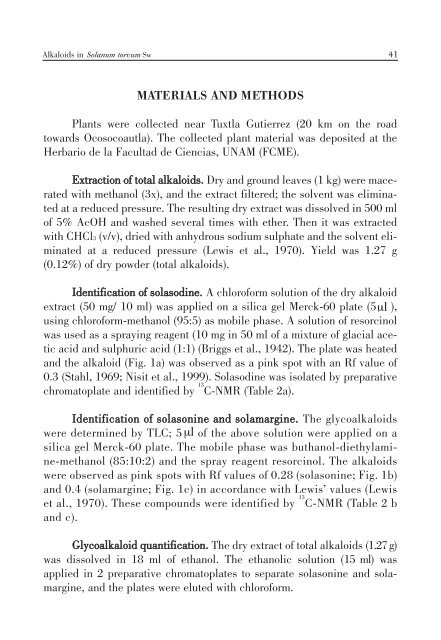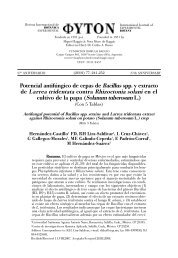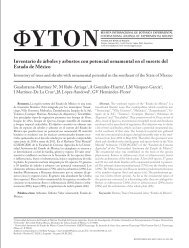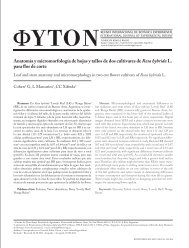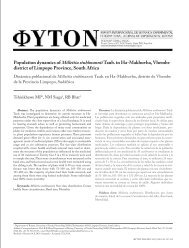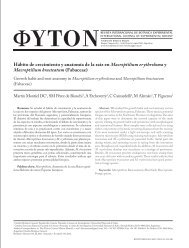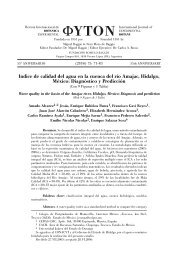Alkaloids in Solanum torvum Sw (Solanaceae) - Phyton
Alkaloids in Solanum torvum Sw (Solanaceae) - Phyton
Alkaloids in Solanum torvum Sw (Solanaceae) - Phyton
You also want an ePaper? Increase the reach of your titles
YUMPU automatically turns print PDFs into web optimized ePapers that Google loves.
<strong>Alkaloids</strong> <strong>in</strong> <strong>Solanum</strong> <strong>torvum</strong> <strong>Sw</strong><br />
41<br />
MATERIALS AND METHODS<br />
Plants were collected near Tuxtla Gutierrez (20 km on the road<br />
towards Ocosocoautla). The collected plant material was deposited at the<br />
Herbario de la Facultad de Ciencias, UNAM (FCME).<br />
Extraction of total alkaloids. Dry and ground leaves (1 kg) were macerated<br />
with methanol (3x), and the extract filtered; the solvent was elim<strong>in</strong>ated<br />
at a reduced pressure. The result<strong>in</strong>g dry extract was dissolved <strong>in</strong> 500 ml<br />
of 5% AcOH and washed several times with ether. Then it was extracted<br />
with CHCl3 (v/v), dried with anhydrous sodium sulphate and the solvent elim<strong>in</strong>ated<br />
at a reduced pressure (Lewis et al., 1970). Yield was 1.27 g<br />
(0.12%) of dry powder (total alkaloids).<br />
Identification of solasod<strong>in</strong>e. A chloroform solution of the dry alkaloid<br />
extract (50 mg/ 10 ml) was applied on a silica gel Merck-60 plate (5 l),<br />
us<strong>in</strong>g chloroform-methanol (95:5) as mobile phase. A solution of resorc<strong>in</strong>ol<br />
was used as a spray<strong>in</strong>g reagent (10 mg <strong>in</strong> 50 ml of a mixture of glacial acetic<br />
acid and sulphuric acid (1:1) (Briggs et al., 1942). The plate was heated<br />
and the alkaloid (Fig. 1a) was observed as a p<strong>in</strong>k spot with an Rf value of<br />
0.3 (Stahl, 1969; Nisit et al., 1999). Solasod<strong>in</strong>e was isolated by preparative<br />
chromatoplate and identified by 13 C-NMR (Table 2a).<br />
Identification of solason<strong>in</strong>e and solamarg<strong>in</strong>e. The glycoalkaloids<br />
were determ<strong>in</strong>ed by TLC; 5 of the above solution were applied on a<br />
silica gel Merck-60 plate. The mobile phase was buthanol-diethylam<strong>in</strong>e-methanol<br />
(85:10:2) and the spray reagent resorc<strong>in</strong>ol. The alkaloids<br />
were observed as p<strong>in</strong>k spots with Rf values of 0.28 (solason<strong>in</strong>e; Fig. 1b)<br />
and 0.4 (solamarg<strong>in</strong>e; Fig. 1c) <strong>in</strong> accordance with Lewis’ values (Lewis<br />
et al., 1970). These compounds were identified by 13 C-NMR (Table 2 b<br />
and c).<br />
Glycoalkaloid quantification. The dry extract of total alkaloids (1.27 g)<br />
was dissolved <strong>in</strong> 18 ml of ethanol. The ethanolic solution (15 ml) was<br />
applied <strong>in</strong> 2 preparative chromatoplates to separate solason<strong>in</strong>e and solamarg<strong>in</strong>e,<br />
and the plates were eluted with chloroform.


